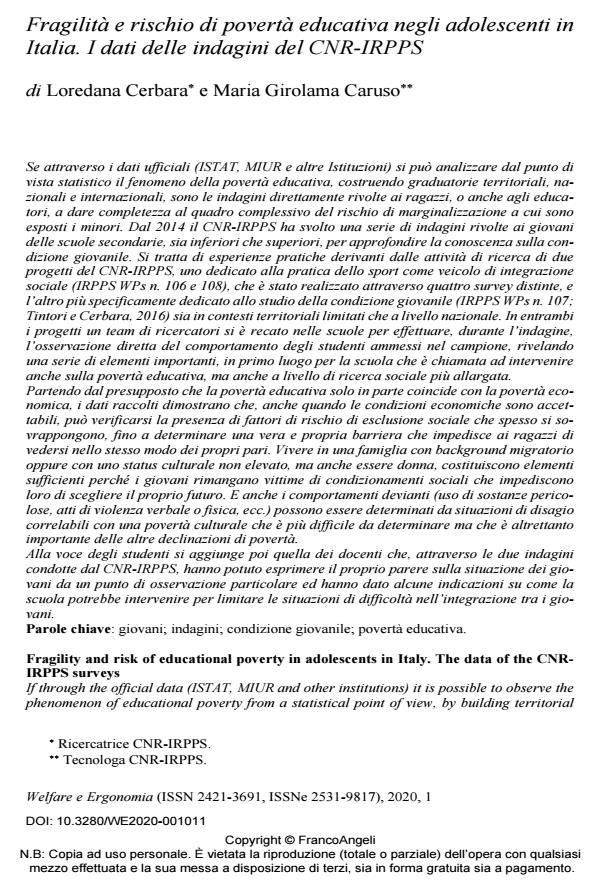Fragility and risk of educational poverty in adolescents in Italy. The data of the CNR-IRPPS surveys
Journal title WELFARE E ERGONOMIA
Author/s Loredana Cerbara, Maria Girolama Caruso
Publishing Year 2020 Issue 2020/1
Language Italian Pages 9 P. 119-127 File size 268 KB
DOI 10.3280/WE2020-001011
DOI is like a bar code for intellectual property: to have more infomation
click here
Below, you can see the article first page
If you want to buy this article in PDF format, you can do it, following the instructions to buy download credits

FrancoAngeli is member of Publishers International Linking Association, Inc (PILA), a not-for-profit association which run the CrossRef service enabling links to and from online scholarly content.
If through the official data (ISTAT, MIUR and other institutions) it is possible to observe the phenomenon of educational poverty from a statistical point of view, by building territorial rankings, both national and international, it is the research carried out on children, or even on educators, to understand and complete the overall picture of the risk of marginalization to which minors are exposed. Since 2014, the CNR-IRPPS has carried out a series of surveys on young people of secondary schools, both lower and higher, to deepen the knowledge of the youth condition. These are practical experiences deriving from the research activities of two CNR-IRPPS projects, one dedicated to the practice of sport as a vehicle for social integration (IRPPS WPs n. 106 e 108), which was carried out through the implementation of four distinct surveys, and the other more dedicated to the study of youth condition (IRPPS WPs n. 107; Tintori e Cerbara, 2016) both in limited territorial contexts and at national level. Researchers went physically to schools to carry out during the survey, the direct observation of the behav-ior of the students admitted in the sample, revealing a series of important elements, first of all for the school which is called to intervene also on educational poverty, but also at a wider social research level. Assuming that educational poverty only partially coincides with economic poverty, the data collected and its own barrier that protects children from seeing themselves in the same way as their peers. Living in a family with a migratory background or with a non-high cultural status, but also being a woman, the fundamental elements observed so that young people re-main victims of social conditions that prevent them from choosing their own future. And even deviant changes (use of dangerous substances, acts of verbal or physical violence, etc.) can be described by uneasy situations related to cultural poverty. The voice of the students is then added to that of the teachers who, through the two surveys conducted by the CNR-IRPPS, were able to express their opinion on the situation of young people from a particular observation point and gave some indications on how the school could intervene to limit situations of difficulty in integrating young people.
Keywords: Young people; surveys; youth conditions; educational poverty.
Loredana Cerbara, Maria Girolama Caruso, Fragilità e rischio di povertà educativa negli adolescenti in Italia. I dati delle indagini del CNR-IRPPS in "WELFARE E ERGONOMIA" 1/2020, pp 119-127, DOI: 10.3280/WE2020-001011